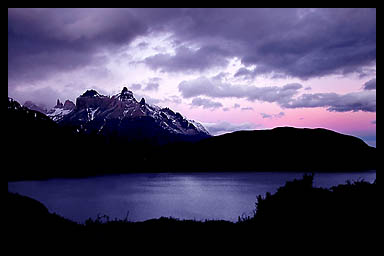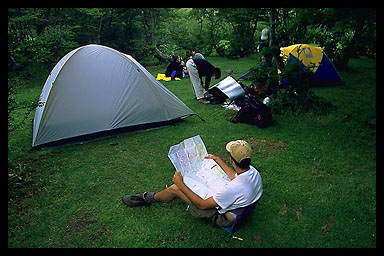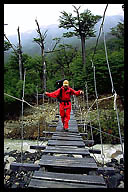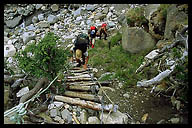Stories / South America / Chile |
||||||||
Rain, Snow, and a Group of Chilean High School GirlsAt the southern tip of Chile, Martin sets out to trek the Torres del Paine Circuit and learns, the hard way, why Patagonia is notorious for some of the worst weather in the world.by Martin Wierzbicki“The pass is closed.” We stare in disbelief at the park ranger. “Too many snows this year,” he explains in broken English as we exchange nervous glances, “it is not possible to make the Paine Circuit.” Rahul and I are devastated. For the last four days, we’d been on a ferryboat crowded with cattle, freight containers and a few adventurous backpackers, traveling 1500km down the desolate coast of southern Chile to trek the Paine Circuit. In the dimly lit interior of the ferry, we’d huddled over contour maps of the park and planned every minute detail of the trek. We’d read the guidebook cover-to-cover, researched each campsite, discussed our food supplies, and reviewed our equipment. Everything was perfect. We were ready. And now this. It’s impossible to complete the 100km Paine Circuit without crossing the John Gardner pass and the pass is snowbound. Defeated and deflated, we roam the streets of Puerto Natales, looking for a place to share our misery with other trekkers. The contradictory reports slowly begin to filter in. A Canadian couple has heard from an Australian trekker that two Germans made it across the pass a few days ago. “No, no, no. It is definitely closed,” warns a dour French hiker. But a Norwegian climber just met a Dutch guy who had crossed the pass. Someone else mentions the two Germans. A mountain guide, who has just returned from the park, encourages us to go for it. “You can always turn back,” he adds with a taunting smile. “Well, why not?” we agree, against our better judgment.
—————— The snow-capped granite spires of the Torres del Paine reach into the sky, forming a mountainous cathedral on the distant horizon that rises to dizzying proportions as we approach the park. Our bus follows a dusty, winding track through the windswept steppes of southern Patagonia. It’s a three-hour trip from Puerto Natales into the park. We arrive in the early evening as a light drizzle begins to fall. By the time we set up our camp at the foot of the Torres, the sky fades into night and stars begin to appear through windows in the clouds. The Patagonian sky is vast, forbidding, wild, and grows more intriguing with the harsh, gray light of the rising moon. A rain cloud passes overhead. As the raindrops catch the light of the moon, a faint lunar rainbow appears across the night sky. Tonight, we’re sharing our campsite with a lively group of Peace Corps volunteers from Bolivia. To celebrate our first night in the park, we mix a bottle of pisco and cola, a popular local drink. The bottle circulates around the campfire as we share stories, travel tales, and reminisce about the simple comforts of home. “Hay fiesta?” A group of drunken Chilean high school girls stumbles over from the next campsite. They join us to toast marshmallows and sing campfire songs. We drink and sing and talk late into the night. —————— The rain begins the moment we step out of our tent, at first a light drizzle, intensifying to a downpour as we race to finish a bowl of oatmeal. At least it’s not snowing. Or, rather, it probably is snowing at higher elevations, on the pass. I lift my pack on put it on. “It wasn’t this heavy yesterday,” I grumble clipping together the waist belt.
We hike for four hours to Puesto Seron, following the wide valley of the Rio Paine, stopping frequently to catch our breath, adjust our backpacks and re-lace our hiking boots. Looking up, my eyes trace the precipitous face of a nearby mountain, from the verdant foothills to the sheer granite cliffs and first snowfields, where it disappears into the clouds. The trail follows a cattle fence through fields and forests, occasionally crossing an icy stream on a makeshift bridge of fallen logs or conveniently arranged stones. A lonely gaucho passes us, riding his horse in the opposite direction behind a small herd of cattle. We stop for lunch at Puesto Seron. I’m relieved to finally put down my pack, which has gradually become an impossibly heavy burden. Even now, my feet are showing the first signs of blisters. We’d be camping here tonight if we’d followed the guidebook’s advice. Instead, we have to trek another four hours to Camparmento Coiron—in the rain. “Don’t worry,” Rahul reassures me, trying the make the best of an increasingly difficult situation, “the first day is always the hardest.”
In the afternoon, fatigued and breathing heavily, we climb a low pass to catch our first view of Lago Paine in the valley below. Above the pass, a condor effortlessly sails the thermals, silently mocking our effort and exertion. The trail traces the left bank of the lake for several hours, rising and dropping frequently with the contours of the terrain. By the time we reach our campsite in the early evening, I’m completely drained of strength, struggling to lift each foot. I’m beginning to understand why they call this the "pain" circuit. We pitch our tent in a steady rain and quietly eat our dinner around the remaining ambers of the campfire as sudden, furious gusts of frozen wind rage down from the mountains and glaciers of the Torres. A few minutes later, I collapse in the tent, exhausted. Rapidly drifting into unconsciousness, my mind becomes crowded with questions and anxieties. How long will this rain continue? Will the pass be snowbound when we arrive? Why am I even here? [ next page | Within an hour we’re standing in a labyrinth of stunted trees, lost, looking for clues ] |



